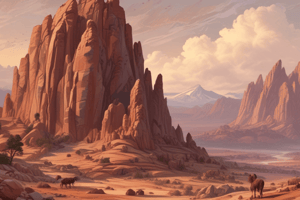Podcast
Questions and Answers
How are igneous rocks formed?
How are igneous rocks formed?
Igneous rocks are formed by the cooling and crystallization of molten rock.
Intrusive and extrusive igneous rocks are classified based on what criteria?
Intrusive and extrusive igneous rocks are classified based on what criteria?
How quickly the molten rock cools and crystallizes, and where this occurs with respect to Earth's surface.
What is required to generate an igneous rock with a fine-grained texture?
What is required to generate an igneous rock with a fine-grained texture?
A fine-grained texture is the product of rapid cooling and crystallization of lava.
A phaneritic texture is characteristic of a(n) __________ igneous rock that cooled __________.
A phaneritic texture is characteristic of a(n) __________ igneous rock that cooled __________.
What does it mean if an igneous rock has an aphanitic texture?
What does it mean if an igneous rock has an aphanitic texture?
What three components make up most magmas?
What three components make up most magmas?
Name two minerals that are unlikely to coexist in the same igneous rock.
Name two minerals that are unlikely to coexist in the same igneous rock.
Igneous rocks of felsic composition have __________ and __________ relative to mafic igneous rocks.
Igneous rocks of felsic composition have __________ and __________ relative to mafic igneous rocks.
Mafic igneous rocks are rich in Fe, Mg, and Ca.
Mafic igneous rocks are rich in Fe, Mg, and Ca.
What is a potential rock name for a mafic rock with a phaneritic texture?
What is a potential rock name for a mafic rock with a phaneritic texture?
What minerals make up rhyolite?
What minerals make up rhyolite?
Which mineral class makes up most igneous rocks?
Which mineral class makes up most igneous rocks?
Peridotite is the main constituent of which part of the Earth?
Peridotite is the main constituent of which part of the Earth?
Which two minerals define a felsic composition?
Which two minerals define a felsic composition?
What is one way a glassy texture forms?
What is one way a glassy texture forms?
Which of the following describes a texture containing bubble-shaped cavities?
Which of the following describes a texture containing bubble-shaped cavities?
Which of the following textures describes an igneous rock with anomalously large crystals?
Which of the following textures describes an igneous rock with anomalously large crystals?
What does an igneous rock with a pyroclastic texture tell a geologist?
What does an igneous rock with a pyroclastic texture tell a geologist?
Which of the following textures indicates two stages of cooling and crystallization?
Which of the following textures indicates two stages of cooling and crystallization?
Which of the following igneous rocks contains no mineral crystals?
Which of the following igneous rocks contains no mineral crystals?
What is the term used to describe a very large, widespread, and deep intrusive body of igneous rock?
What is the term used to describe a very large, widespread, and deep intrusive body of igneous rock?
In what type of igneous feature would you find rocks with a vesicular texture?
In what type of igneous feature would you find rocks with a vesicular texture?
What texture would you expect a thin, dark-colored igneous sill to possess?
What texture would you expect a thin, dark-colored igneous sill to possess?
How do you account for the complex mineralogy of a light-colored, fine-grained igneous rock with very large dark-colored crystals?
How do you account for the complex mineralogy of a light-colored, fine-grained igneous rock with very large dark-colored crystals?
Ultramafic rocks contain __________ and are commonly found in __________.
Ultramafic rocks contain __________ and are commonly found in __________.
What is an accessory mineral?
What is an accessory mineral?
Which of the following best describes the difference between granite and rhyolite?
Which of the following best describes the difference between granite and rhyolite?
What is the rock name of an intermediate rock with two distinct grain sizes?
What is the rock name of an intermediate rock with two distinct grain sizes?
What do pumice and scoria have in common?
What do pumice and scoria have in common?
At a subduction zone, melting is triggered by _____.
At a subduction zone, melting is triggered by _____.
Which of the following statements best describes the relationship between pressure and melting point in the Earth's Interior?
Which of the following statements best describes the relationship between pressure and melting point in the Earth's Interior?
Flashcards are hidden until you start studying
Study Notes
Formation of Igneous Rocks
- Formed by the cooling and crystallization of molten rock.
Classification of Igneous Rocks
- Classified as intrusive or extrusive based on cooling rate and location relative to Earth's surface.
Textures of Igneous Rocks
- Fine-grained texture results from rapid cooling of lava; often seen in extrusive rocks.
- Aphanitic texture indicates too-small mineral crystals to be visible; characteristic of fast-cooled lava.
- Phaneritic texture is associated with intrusive rocks, which cool slowly below the surface.
Mineral Composition
- Most magmas consist of liquid, solid, and gaseous portions.
- Felsic rocks contain more silica and lower melting temperatures than mafic.
- Mafic rocks are rich in iron, magnesium, and calcium.
Rock Types and Examples
- Gabbro is a potential name for a phaneritic mafic rock.
- Rhyolite consists of quartz, K-feldspar, and plagioclase feldspars, with fewer biotite and amphibole.
- Ultramafic rocks, predominantly olivine, are found in the mantle.
- Andesite porphyry represents intermediate rocks with distinct grain sizes.
Textural Features of Igneous Rocks
- Vesicular texture contains bubble-shaped cavities and occurs in lava flows.
- Pegmatitic texture features unusually large crystals.
- Pyroclastic texture indicates formation by violent volcanic eruptions.
- Porphyritic texture reflects two stages of cooling and crystallization.
Specific Rock Characteristics
- Obsidian is an igneous rock without mineral crystals.
- Batholiths are large, deep intrusive bodies of igneous rock.
Geological Processes
- Melting at subduction zones is triggered by the introduction of water.
- Increased temperature correlates with increased pressure, raising melting points in the Earth's interior.
Accessory Minerals
- Accessory minerals only make up a small proportion of the rock's total composition.
Comparison of Rocks
- Granite has a phaneritic texture, whereas rhyolite has an aphanitic texture, highlighting the cooling rates.
- Pumice and scoria share a vesicular texture, both formed from gas-rich volcanic activity.
Studying That Suits You
Use AI to generate personalized quizzes and flashcards to suit your learning preferences.




